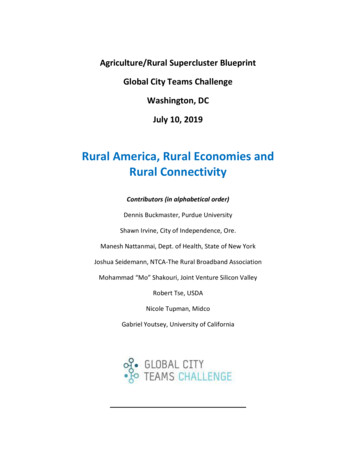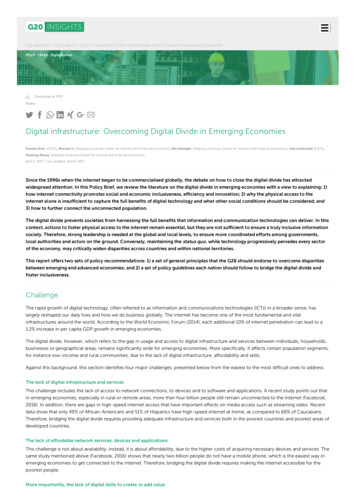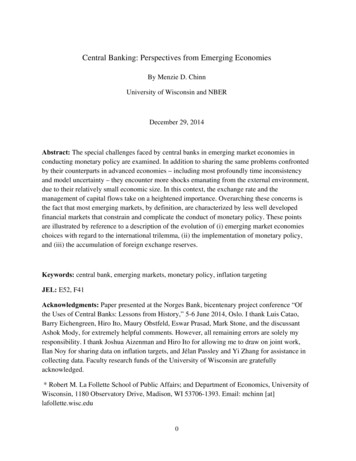
Transcription
Agriculture/Rural Supercluster BlueprintGlobal City Teams ChallengeWashington, DCJuly 10, 2019Rural America, Rural Economies andRural ConnectivityContributors (in alphabetical order)Dennis Buckmaster, Purdue UniversityShawn Irvine, City of Independence, Ore.Manesh Nattanmai, Dept. of Health, State of New YorkJoshua Seidemann, NTCA-The Rural Broadband AssociationMohammad “Mo” Shakouri, Joint Venture Silicon ValleyRobert Tse, USDANicole Tupman, MidcoGabriel Youtsey, University of California
Rural America and Rural Economies Need Broadband ConnectivityWe live in a connected world; a connection that starts with broadband internet accessto the home or business. That basic connectivity fuels innovation and propels economies acrossthe globe. Quoting a Pew Research Center study, the Federal Communications Commission(FCC) reported that two-thirds of Americans believe that the lack of a high-speed internetconnection at home would be a "major disadvantage to finding a job, getting healthinformation or accessing other key information." 1Despite the need for connectivity, many areas in rural America continue to lag behindurban areas in terms of broadband internet access. A 2018 survey found that more than 90% ofsmall, locally operated communications providers offer fiber to the home, offering fiber-basedbroadband to nearly 60% of their customers.2 Cable companies, as well, have been part ofcritical broadband deployment efforts through coax and fiber networks.3 However, terrain andeconomics involved in building out fiber networks in rural America has left a “digital divide”between urban and rural areas. A “rural/rural” divide even exists between areas served bylocally operated communications providers and areas served by communications providers thatfocus efforts on their larger, more densely populated service areas. The “rural/rural” divideillustrates the need for comprehensive policies that support broadband deploymentthroughout the United States. Universal service policies, as established by Congress and1The FCC published these findings in an annual report released in January 2016. The FCC is required byCongress to issue a report each year describing the state of broadband deployment in the United States.See, Inquiry Concerning the Deployment of Advanced Telecommunications Capability to All Americans ina Reasonable and Timely Fashion, and Possible Steps to Accelerate Such Deployment Pursuant to Section706 of the Telecommunications Act of 1996, as Amended by the Broadband Data Improvement Act: 2016Broadband Progress Report, FCC Docket No. 15-191, FCC 16-6, at para. 40 (2016) (available athttps://apps.fcc.gov/edocs rnet Availability Survey Report, NTCA–The Rural Broadband Association, at 4, 5 (Dec.2018) s/201812/2018%20Broadband%20Survey%20Report FINAL.pdf).3NCTA, Cable’s Story, https://www.ncta.com/cables-story (last accessed June 11, 2019).1
supported further by other programs administered by the U.S. Department of Agriculture, haveresulted in admirable broadband capabilities in many rural areas.Broadband connectivity can be provided by a variety of technologies. Each platform canoffer unique attributes to meet specific needs. Wired networks boast security and resilience;fiber optics are often referred to as “future proof,” referring to the ability to increase capacityby adding electronic components at the physical ends of the fiber. Fixed wireless networks(described more fully in the Midco case study below) allow fiber providers to “edge out” theirfiber connectivity by deploying fixed wireless equipment on local grain elevators, water towers,commercial towers, tall buildings, etc. and then backhauling that traffic to the fiber network. Atthe same time, mobile wireless technologies are necessary to support critical applications “onthe move.” Mobile and fixed broadband services work in concert to provide comprehensiveaccess to critical applications that support rural economic development, education and healthcare. As noted by the FCC, fixed and mobile broadband services, while not full substitutes foreach other, are each “important services that provide different functionalities, tailored to servedifferent consumer needs.”4 The FCC has concluded that consumers require access to bothwired and mobile services.5 However, even where a predominantly wireless solution may be apreferred solution due to terrain or other factors, wireless networks at their core require awired infrastructure to convey traffic.6 Properly drafted policies can account for the need forboth wired and wireless technologies, and can provide much-needed connectivity to rural4Inquiry Concerning the Deployment of Advanced Telecommunications Capability to All Americans in aReasonable and Timely Fashion: 2018 Broadband Deployment Report, Docket No. 17-199, FCC 18-10, atpara. 18 (2018).5See, Inquiry Concerning the Deployment of Advanced Telecommunications Capability to All Americansin a Reasonable and Timely Fashion, and Possible Steps to Accelerate Such Deployment Pursuant toSection 706 of the Telecommunications Act of 1996, as Amended by the Broadband Data ImprovementAct: 2016 Broadband Progress Report, FCC Docket No. 15-191, FCC 16-6, at para. 40 (2016) (available athttps://apps.fcc.gov/edocs public/attachmatch/FCC-16-6A1.pdf).6"The Truth About Wireless Broadband," Foundation for Rural Service, Washington, DC (produced withassistance from John Staurulakis, Inc., Monte R. Lee and Company, and Palmetto Engineering (2011)(available at http://www.frs.org/images/The Truth About Wireless Broadband.pdf).2
America. That connectivity, in turn, enables rural America to engage in and benefit frominnovation – and build stronger rural economies in multiple ways:TelehealthRural areas often lack access to healthcare resources:“Rural residents who live on farms, ranches, reservations and frontiers oftenmust travel long distances to reach a health care provider. That means takinghours off from work for an initial appointment or follow-up, which causes manyto delay or avoid care. Greater distances also result in longer wait times for ruralemergency medical services (EMS). That can endanger patients requiring EMStreatment. “If you’re bleeding, in that extra 15 minutes (before help arrives), youcan die,” said Gary Hart, PhD, director of the Center for Rural Health, Universityof North Dakota School of Medicine and Health Sciences, in Grand Forks.” 7One solution to addressing the rural healthcare crisis is the use of telehealth:The range and use of telehealth services have expanded over the past decades,along with the role of technology in improving and coordinating care. Traditionalmodels of telehealth involve care delivered to a patient at an originating (orspoke) site from a specialist working at a distant (or hub) site. A telehealthnetwork consists of a series of originating sites receiving services from acollaborating distant site.Telehealth is defined as the use of electronic information andtelecommunication technologies to support long-distance clinical healthcare,patient and professional health-related education, public health and healthadministration. Technologies include video conferencing, the internet, store-7Association of American Medical Colleges, Health Disparities Affect Millions in Rural U.S. Communities(Oct. 31, 2017), disparities-affect-millions-rural-uscommun/ (last accessed June 11, 2019).3
and-forward imaging, streaming media, and terrestrial and wirelesscommunications.8Telehealth is a well-proven solution to combatting rural healthcare needs. Patients notonly have more access to healthcare providers, but also limit their travel time to attendappointments, limit their time away from work, while also continuing to work in and contributeto the local economy. The quantified findings are impressive. National average estimates ofrural costs savings include:Travel expense savings: 5,718 per medical facility, annually;Lost wages savings: 3,431 per medical facility, annually;Hospital cost savings: 20,841 per medical facility, annually;Increased local revenues for lab work: 9,204- 39,882, per type of procedure, permedical facility, annually; andIncreased local pharmacy revenues: 2,319- 6,239 per medical facility, annually,depending on the specific drug prescribed.9Internet connectivity is a prerequisite to providing telehealth services. While relativelylow-bandwidth services can support basic monitoring, high-capacity broadband is necessary toenable synchronous video-conferencing that supports physician/patient interactions in “realtime.” These connections facilitate dialogue as well as mental health, physical therapy andoccupational therapy interactions.8Health Resources & Services Administration, Telehealth, html (last accessed June 11, 2019).9Schadelbauer, Rick, “Anticipating Economic Returns of Rural Telehealth,” Smart Rural Community,NTCA–The Rural Broadband Association cuments/201712/SRC whitepaper anticipatingeconomicreturns.pdf)4
TelecommutingTelecommuting is becoming an increasingly common way for Americans to work, andfor individuals and companies to save costs in a dailycommute, office space, etc.10 In rural America,telecommuting provides gainful employment whileallowing families to remain in their communities. In atraditional family farm, for example, the husband maywork the family farm while the wife telecommutes andsells insurance, provides data entry services, works in IT,etc. The family can continue to work and live where theyFigure 1: Rural Flight Graphicwant, while supporting their families and contributing more to their local economies.Telecommuting also helps combat rural flight. As shown in Figure 1, many areas in ruralAmerica are experiencing rural flight as younger generations move to more urban areas forincreased educational and employment opportunities.11 Telecommuting offers younger peoplea viable job while remaining in their communities, as summarized in the following story:When 28-year-old Derek Gleim graduated as a computer programmer four yearsago, he hardly expected he would craft a career as an IT professional in hishometown of Menasha, Wis. “I wanted to live with my parents in Menasha,where life is simple and inexpensive,” he said. “But I was sure that to get that bigbreak I had to move out to a city that's more urban; Menasha is a small, ruraltown.”10Paul C. Boyd, Ph.D, Six Organizational Benefits of Telecommuting, s.html (last accessed June 11, 2019).11U.S. Dep’t of Agriculture, Economic Research Service, Population Change by Metro/Nonmetro t-gallery/gallery/chart-detail/?chartId 55975.5
He was pleasantly surprised when he landed a project manager job at RuralAmerica Onshore Sourcing, a Louisville, Ky.-based IT company that providesbusiness process outsourcing services using professionals who telecommutefrom rural areas.“Aside from his capabilities, we could hire Derek because – despite living in‘Middle of Nowhere,’ Wisconsin – he had access to broadband,” said ChristopherHytry Derrington, the company's CEO.Gleim said he’s lucky. Although a large section of rural Wisconsin still lacksbroadband, he lives in a place that has it. “Broadband is making it possible to dowhat I want to do, by living where I want to live,” he said.12Gleim’s story is one of many thousands of rural telecommuters. For example, in McKee, Ky.(pop. 800), Peoples Rural Telephone Cooperative supports Teleworks USA, a recruitment toolthat offers jobseeker services to bring cutting-edge telework employment opportunities toworkers, especially in rural areas and small towns. It has generated more than 3 million ineconomic activity and connected nearly 1,500 employees with their jobs – income which canthen flow back to the local rural economy.13 A 100,000 grant from the U.S. Department ofAgriculture helped Teleworks USA make a difference.14 Rural broadband connectivity canencourage even more rural Americans to remain in their communities, work from home, andcontribute to their local economies with their wages.12Digital Communities, Giving Rural America a Competitive Edge (Oct. 15, ral-America-a-Competitive-Edge.html (last accessedJune 11, 2019).13See, generally, www.teleworkusa.com.14“TeleworksUSA to Expand Services, Outreach in Six Eastern Kentucky Counties Thanks to New USDAGrant,” Lane Report, Lexington, KY (Oct. 3, ern-kentucky-counties-thanks-to-new-usda-grant/).6
Smart AgricultureIf sufficient connectivity exists in rural America, then farmers and ranchers can benefitfrom the continuing innovation of smart or precision agriculture. Smart agriculture increasesyields in numerous ways: monitoring soil conditions to tailor the seeds for the soil type to yieldthe best harvest for certain crops; tailoring fertilizers for soil and crop type; and automatingwatering. Moreover, connectivity supports logistics, which is an increasingly important aspectof farming. This enables producers to align prime harvest times with transportation to market,as well as the incorporation of block chain imprints. Smart agriculture enjoys applications inlivestock and dairy production, row crops and specialty crops.The agricultural industry is producing ever-larger quantities of digital data, to the pointthat the term "big data" is now widely used across the industry. Many stakeholders believe thatthe means by which agriculture will feed the world in 2050, without bringing more land intoproduction, will be through the better use of data and data analytics. Deployment of a varietyof sensors in agricultural machinery, farm fields, grain storage, food processing, animal collars,etc. has created an era of Ag Informatics, where real-time information gathering, storage,analysis, and interpretation is enabling decision-making on the go (Buckmaster et al., 2016). TheAg Informatics needs of the 21st century demand that students are well versed in statisticalplatforms, shell scripting tools, data pipelines, visualizations, database technology, working onremote systems of computational clusters (rather than on desktops/laptops), computingmassively in parallel, and utilizing modern software data analysis platforms and tools, such as R,Python, Hadoop, Spark, etc. Due to this explosive growth in data-driven Ag Informatics, there isa strong need for innovative training methods in data analysis. According to a recent McKinseyreport, data science employment in the United States will face a shortfall of more than 250,000qualified individuals. Globally, the situation is similar, where demand for data scientists isprojected to exceed supply by more than 50% by 2018.1515Gerskoff, A. 2015. How to stem the global shortage of data scientists. Available e-global-shortage-of-data-scientists/ (accessed May6, 2019).7
Smart agriculture also improves the quality of life for farming families by allowingfarmers to monitor their operations remotely. Smart sensors, for example, allow farmers tomonitor the cows’ labor progressions remotely, instead of living in the barn during calvingseason. Without a need to monitor operations on the farm in person, farmers can attend familyevents, coach their kids’ athletic leagues, pursue a higher education degree, or seeksupplemental income from a part-time job. Smart sensors have also increased the safety offarming. Grain dryers, for example, are prone to explosion and collapse. During grain dryingseason, IoT (Internet of Things) technologies can alert farmers and help grain silo management,reducing the risk of injuries while increasing operational efficiencies.16 By way of example,OSHA standards regulate the relative speed of feeding conveyors to bucket elevators;conveyors that run too fast can cause grain dust fires and explosions. Sensors can determinewhen speeds are approaching hazardous conditions, trigger alarms and stop the conveyor.17Food safety is another area where smart ag, broadband as the enabling technology, andFood Safety Modernization Act (FSMA) Regulations interact for real time decision making thatimproves food safety under FSMA. Smart ag technology offers multiple benefits from thefarmer/ process/ food chain perspective and an opportunity to meet regulatory requirementswhether in food safety, environmental rules, water regulation, health of workers and animalswith de minimis additional cost. Block chain technology can reduce waste by identifying thespecific source of products, eliminating the need to discard entire stores of produce when theoriginating point of contamination is unknown.In Sioux Center, Iowa (pop. 7,500), Premiere Communications provides broadband tothe 13th largest agriculture-revenue generating county in the nation with more than 1.6 billionin annual crop and livestock sales. A sophisticated network of broadband-powered cameras16“Grain Dust Explosions Up, Injuries and Fatalities Decline,” Agriculture News, Purdue University (Feb21, 2019) ecline.html, deaths-in-silospersist.html).17Jeanne Schweder, “The Internet of Things Inside Grain Operations,” Automation World (May 15, degrain-operations).8
enables livestock producers to monitor livestock through live video feeds, while advancedalarm systems send out mobile and email alerts. Broadband-enabled sensors in feeding binscan measure and dispense the exact amount of feed. Other sensors enable farmers to calibrateplanting with soil conditions and track rainfall to create a mapping database of crop harvest bythe acre. Farmers can download this data to their planting and combine equipment to obtainmaximum yields. Equipment manufacturers connected by Premiere can transmit detailed partsspecifications and drawings in real time and check inventory at each location, enabling shorterrepair times.In Westby, Wisc. (pop. 2,200), Vernon Communications Cooperative supports a grainstorage facility of international food-processing and commodities trading corporation whichprocesses five to six million bushels of corn, soybeans and soft red winter wheat every year.Approximately 180-200 local farmers can spot sell, store or contract their grain. Cloud softwaremaintains employee time cards, vehicle log books and customer databases. Reliable broadbandalso enables farmers (and the company) monitor fluctuating grain prices, communicate thedaily closing bid with customers through text message or email, and maintain real-timecommunication with headquarters through video conferencing and private chat lines.EducationTechnology is shaping the next generation of American jobs. Manufacturing, agricultureand health care are among sectors that are demanding more highly-skilled employees than inthe past. It is projected that science, technology, engineering and math (STEM) jobs willcontinue to grow alongside increasing demand for workers with middle-skill abilities. Careerand Technical Education, or CTE, and traditional college settings can prepare students to meetchanging job markets. In rural areas, broadband can be used to support secondary andpostsecondary education and training.Regional collaboration among educators and industry can tailor training to support localmarkets. These efforts can improve local economic stability, as data indicate that higher wagescorrelate to education.18 The nexus between STEM and agriculture is clear. Smart ag requires18For a comprehensive discussion of this topic, see Joshua Seidemann, “Rural Broadband and the Next Generationof American Jobs,” Smart Rural Community (2019) f).9
software coding, machine learning, data visualization, data wrangling (manipulation) and datainterpretation. Thus, increasing workforce demand and explosive growth of data suggest a needfor developing novel curriculum for training next generation of food, agricultural, naturalresources, and human (FANH) sciences students in functional programming skills (softwareapplication) and computational skills (e.g. accessing, organizing, analyzing, and visualizing data).These skills are critical for providing leadership and communication in academia, industry, andon farm in the 21st century.The quantification of STEM jobs depends upon how “STEM” is defined. For example, theNational Science Foundation (NSF) includes social scientists in STEM jobs, but not science orengineering managers; the U.S. Department of Commerce includes science and engineeringmanagers but does not count social scientists.19 A University of Wisconsin-Madison reportobserves that the lack of standard definitions frustrates accurate analysis of the STEM market.20STEM for rural areas can be defined as both pure and applied disciplines of Science,Technology, Engineering and Mathematics. Traditionally, STEM was focused narrowly oncollege degrees in STEM fields of study. However, the definition of STEM has expanded todifferent levels of education including K-12, two-year schools, 4-H and private industry.An inclusive definition of STEM encompasses a wide range of academic and technicalsubjects, including, but not limited to, the physical sciences (e.g., biology, chemistry, earth andenvironmental science, geosciences, agricultural sciences, physics, astronomy) and socialsciences (e.g., psychology, sociology, political science, anthropology, economics, behavioralsciences), natural and information technology (e.g., computer science, keyboarding, robotics,data analytics, engineering, construction, urban planning, cybersecurity), life sciences, andmathematics education. STEM also includes health care programs that train students forcareers that primarily focus on scientific research.19Stephen Sawchuk, “Is STEM Oversold as a Better Path to Jobs?” Education Week (May 22, 2018).20Amanda Oleson, Matthew Hora and Ross J. Benbow, “What Is a STEM Job? How Different Interpretations of theAcronym Result in Disparate Labor Market Projections,” Wisconsin Center for Education Research, University ofWisconsin-Madison at 2 (Sep. 2014) (Oleson, et. al.).10
In addition to the subjects listed above, STEM includes career / technical education andapprenticeships, which can also be considered Applied STEM. This concept reflects the 21stcentury need for a technically proficient work force that can support major sectors of the ruraleconomy, including precision agriculture, natural resources, manufacturing, government,recreation, and health.21There are, however, consistent findings that the market for STEM jobs is robust andoffers well-paying positions. The Bureau of Labor Statistics (BLS) reported 8.6 million STEM jobsin 2015, an increase of 10.5% from 2009, as compared with 5.2% job growth for non-STEMoccupations.22 BLS concludes that STEM positions constitute 10% of all U.S. jobs and on averagepay almost twice the U.S. average wage.23 These collective findings are consistent with thedetermination that STEM jobs are generally “far more plentiful than is generally understood,and they pay more than the typical jobs available to those with less than a bachelor’s degree,”24and argue for attention to STEM education.In similar vein, the number of jobs supported by CTE is subject to debate,25 though aUniversity of California report finds in various state studies increased earnings that range from14% to 28% across different professions supported by CTE.26 The U.S. Department of Education21See, USDA Task Force on Ag & Rural Prosperity, 2017, USDA Economic Research Service, (2017).22See, Stella Fayer, Alan Lacey and Audrey Watson, “STEM Occupations: Past, Present and Future,” Bureau ofLabor Statistics, U.S. Department of Labor and ILR School, Cornell University (Jan. 2017) ntent.cgi?article 2928&context key workplace).23John I. Jones, “An Overview of Employment and Wages in Science, Technology, Engineering and Match (STEM)Groups,” Employment & Unemployment, Bureau of Labor Statistics, U.S. Department of Labor and ILR School,Cornell University, at 3 (Apr. iewcontent.cgi?article 2279&context key workplace).24Rosenblum and Kazis at 1.25One author notes that a series of studies “do not inspire much confidence in the possibility of reaching clearconclusions from correlational data about how much CTE classes cause increases in earnings.” David Stern,“Pathways or Pipelines: Keep High School Students’ Future Options Open While Developing Technical Skills andKnowledge,” Graduate School of Education, U.C. Berkley, at 9 (2015) (Stern).26Ann Huff Stevens, “What Works in Career and Technical Education (CTE)? A Review of Evidence and SuggestedPolicy Directions,” University of California, Davis, and National Bureau of Economic Research, at 43, 44 and-TechnicalEducation.pdf? ga 880).11
(DOE) reports that 95% of public high school students in 2009 attended a school that eitheroffered CTE on-campus or with a partnering school.27 The DOE also found “the most commonoccupational CTE subject areas for secondary students were business, communications anddesign, and computer and information sciences.”28 Although in recent years overallparticipation in CTE participation has declined slightly, demographic differences across racialand economic categories are declining as participation from among various demographiccategories is achieving greater equivalent proportionality.29Rural broadband providers can play a critical role in efforts to support specialized STEMand CTE education. Broadband-enabled distance education allows all eligible students whohave access to broadband to participate. Distance education can support STEM and middleskills job education, including work-training programs, apprenticeships and focused classroominstruction to help students develop skills and lay the groundwork for economic opportunitiesin rural areas. This is especially important in rural areas. The American Enterprise Institutereports that in 2012, less than 66% of rural schools offered AP courses, as compared with 77%,82% and 91% of town, urban and suburban schools, respectively.30 The concern for ensuringeducational opportunities transcends the individual welfare of students and workers andimplicates overall economic growth that could be frustrated if there is a lack of skilled workers.The U.S.D.A. Economic Research Service ERS reports rural counties with low levels of educationalattainment suffer poor economic outcomes as compared with counties that have higher levelsof educational attainment.31 The Bureau of Labor Statistics BLS reports that adults 25 and older27“National Assessment of Career and Technical Education: Final Report to Congress,” National Assessment ofCareer and Technical Education, U.S. Department of Education, at 16 acte/career-technical-education/final-report.pdf) (NACTE).28NACTE at 19.29See, NACTE at 18, 19; Stern at 7.30Nat Malkus, “The AP Peak: Public Schools Offering Advanced Placement, 2000–12,” American EnterpriseInstitute, Figure 4 and accompanying text (2016) S identifies 467 counties as “low education”—counties where 20% or more of adults 25 to 64 do not have ahigh school diploma; nearly 80% of these counties are rural. Average poverty rates in rural low-education countiesare approximately 8% higher than all other rural counties. 40% of rural low-education counties are also persistent-12
who lack a high school diploma have unemployment rates of 5.4%; those with less than a highschool education have unemployment rates of 8%. Educational attainment in rural areas isincreasing,32 and students with access to broadband are realizing promising results. Youth wholive in areas with broadband are found to have earned higher scores on college entrance examssuch as the SAT or ACT.33 Distance education can be a tool to correct lack of specialization thatmay exist in small rural and can also assist early college. Distance education can also provideflexibility for working students and accommodate ongoing family obligations.The United States Department of Agriculture (USDA) Rural Utilities Service (RUS)Distance Learning Telemedicine (DLT) Program supports rural STEM education by fundingequipment needed to connect to internet / broadband services for distance learning.34 [] USDAalso administers broadband programs that provide the broadband infrastructure necessary toconnect rural educational institutions to the internet. These programs include theTelecommunications Infrastructure Loan Program, Rural Broadband Access Loan Program,Community Connect Grant Program and the Broadband Reconnect Program. The rising level oftechnical (Applied STEM) skills required for precision agriculture is recognized in the new USDANational Institute of Food and Agriculture (NIFA) Agriculture and Food Research Initiative (AFRI)Agricultural Workforce Training Grants.The recent USDA Precision Agriculture and Broadband Report (May 2019) indicates thatuniversal adoption of precision agriculture could add 18 percent in gross econo
broadband to nearly 60% of their customers.2 Cable companies, as well, have been part of critical broadband deployment efforts through coax and fiber networks.3 However, terrain and economics involved in building out fiber networks in rural America has left a digital divide between urban and rural areas.










